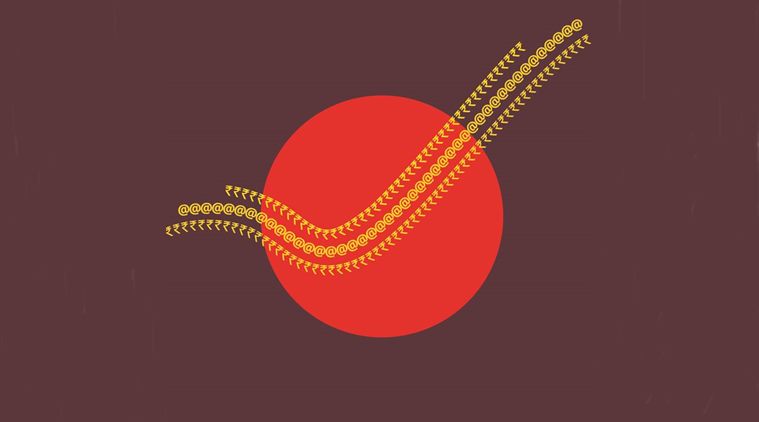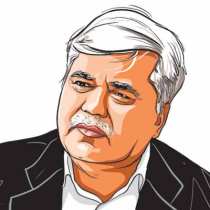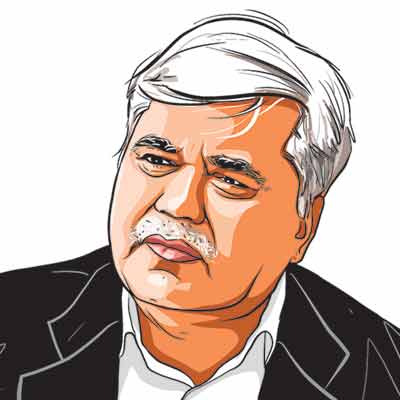Dak babu as bank-teller
Why the India Post Payments Bank could be one of the final pieces in the jigsaw of financial inclusion in the country

Working closely with people for more than 150 years, the Dak Seva has earned their trust and respect. (Illustration by Suvajit Dey)
The village postman was known to be a trusted figure in India. He was privy to even family gossip because very often he would help read and write letters, and not just deliver them. The postman would also bring people money from family members working away from home in the cities.
Working closely with people for more than 150 years, the Dak Seva has earned their trust and respect. That is what multiplies the value of its 1.55 lakh offices and three lakh dedicated employees, unmatched in reach or numbers by the country’s banking sector.
As the needs of the people changed over the years, so did the services delivered by this mammoth organisation. At different times, it sold licences for radio and TV receivers, provided postal deposit facilities or insurance services. It has also kept pace with technology, adopting whatever improved its efficiency.
Today, India stands at the cusp of a digital revolution. Tech-savvy people seldom visit banks, preferring instead to avail of banking services online, often using nothing more than their mobile phones.
However, there is still a digital divide between urban and rural areas of the country because of the high cost of service delivery relative to the total value of transactions that originate there. That’s beginning to change.
Under the Pradhan Mantri Jan Dhan Yojana, 325 million bank accounts have been opened, many with zero balance. This is an enabling step that bridges the gap between those who have access to banking and those who do not. This was made possible by removing an even more basic difference between two sets of people: Those who had an identity document and those who had none. This gap was bridged by India’s Digital ID infrastructure — Aadhaar.
Today, almost every Indian has the 12-digit identity number. By providing online authentication services to open and operate a bank account and access many services, Aadhaar has become an enabler of financial services.
In India, the language of a document can render an otherwise valid ID useless. The validity of an ID could depend on the whims of an official. It is nothing less than a revolution when a proof of identity can be electronically verified in a non-repudiable manner. This unique, scalable, reliable and online ID system empowers individuals — a fact that can be appreciated by those who have struggled with proofs of identity.
With an identity proof and a bank account, Indians are endowed with everything they need to make or receive payments, to obtain credit, to buy insurance or to receive the subsidy due to them — if they have access to the internet or their bank’s branch, of course.
To provide access to the internet, the government has accelerated the connectivity of panchayats with the BharatNet (optical) fibre, coupled with innovative solutions, such as a grid of interoperable wi-fi hotspots for the last mile connectivity. Mobile networks are also becoming data networks.
However, another important challenge needs to be overcome: The lack of internet and mobile services literacy among the rural population. This is not surprising. Many of us can recall that we too were at sea with the technology when we first encountered it.
Even then, some of our recent achievements are mind-boggling. The Unified Payment Interface (UPI), for example, powered 312 million transactions valued at Rs 54,000 crore in August. On September 1, the prime minister inaugurated the India Post Payments Bank (IPPB), which begins with 650 branches. This in addition to 3,250 access points in post offices. The IPPB is set to spread its footprint to 1.55 lakh access points by December 2018. This move has created the country’s largest banking network with direct presence at the village level.
The familiar and friendly “dak babu” shall now be the bank-teller who will be at the doorstep of senior citizens, homemakers, small businesses, rural influencers like teachers, paramedics and local representatives, urban migrants, kirana stores, farmers, DBT beneficiaries and students. Just as the State Bank of India brought banking and credit to the people in a big way in the 1950s, the IPPB can bring similar services (now with digital payments facility) to the people who have not had access to these services.
The postman needs a mobile phone, a fingerprint scanner and a little training to be fully equipped to provide day-to-day banking and post office services. Some 18,000 of them had such facilities on day one itself.
This innovation can bring micro enterprises (which constitute 99 per cent of India’s 60 million “micro, small and medium enterprises”, or the MSME sector) on board for digital transactions. These merchants largely operate in the informal economy, their literacy levels are low and they operate on a small scale. They have multiple challenges in using digital payment solutions. They also have difficulties collecting dues from customers and lack working capital for, or access to, institutional credit mechanisms. They do, however, have a significant cash footprint.
Together with the revamped GST, UPI 2.0 interface, and the RBI’s Public Credit Registry (PCR), the IPPB can provide credit worthiness data and thus remedy the lack of access to credit to these entities. This could be a game changer for a large number of micro enterprises and the lives they touch.
When it comes to devising innovative solutions, the country does not lack talent. The government can unleash this energy for economic development by working on the enabling measures it has taken so far, including IPPB.
IPPB has started well by adopting user-friendly processes (QR code in place of passwords and account numbers for semi-literate population), robust biometric authentication with Aadhaar, an assurance of 4 per cent rate of interest with no minimum balance requirements, and leveraging ICT solutions for minimising and addressing consumer complaints.
But more than its reach and goodwill, this new bank will be sustained by innovative approaches to solving problems. Collaboration with the third-party service providers, for example, for servicing loans and insurance, or giving boost to entrepreneurship schemes under the Mudra Yojana, Startup India, Standup India and social security schemes under Jan Suraksha are the kind of initiatives that highlight the potential of this new initiative.
IPPB could be one of the final pieces in the jigsaw of financial inclusion for the entire country.
The writer is the Chairman of TRAI. Views are personal
For all the latest Opinion News, download Indian Express App
More From R. S. Sharma
- Truth fears no trollsNothing was hacked and no harm done because I gave out my Aadhaar number. There is a concerted effort to discredit Aadhaar...
- Why I gave out my Aadhaar numberThe point behind it is simple: Aadhaar does not contribute to increasing any of your other digital vulnerabilities..
- Who owns my data?A citizen-centric data eco-system is necessary to protect privacy. ..







































No hay comentarios:
Publicar un comentario